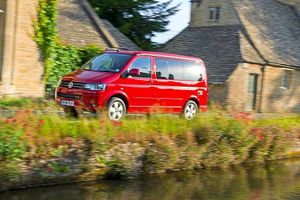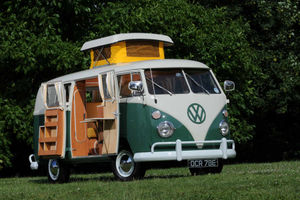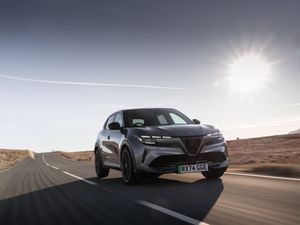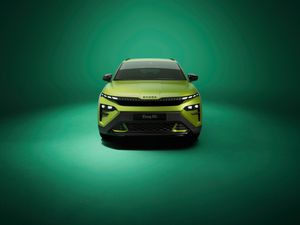New Sportline van marks a milestone for VW
Volkswagen has unveiled the ultimate van, equipped with a powerful engine and the sort of creature comforts you'd expect in a classy saloon.



It's great news for those who spend up to eight hours in the cab, but this new Sportline is special in another way, as it is the company's way of celebrating 60 years since the first of its iconic Transporter vans was sold in the UK.
The Transporter is one of VW's greatest success stories, with sales still only outstripped by the Ford Transit: a relative Johnny-come-lately which has only been around for a mere half century. To date more than 11,500,000 Transporters have been sold worldwide, in forms including a panel van, window van, combi, pick-up and, of course, the legendary camper vans which are still hugely popular, attracting hundreds of enthusiastic owners to events all over Britain.
Its story dates back to turbulent times. In 1945, after the British captured the VW factory at Wolfsburg, Yorkshireman Ivan Hirst (a British Army officer and engineer) resurrected the plant to build a new generation of Beetles. To solve the problem of moving components and machinery around the large site, the Plattenwagen was built: a flatbed truck powered by a flat-four, air-cooled Beetle engine at the rear. By 1947, this had evolved into the first Transporter and in 1954 the first examples were exported to Britain.
With a tiny 1,200cc engine turning out just 30Ps of power, it could carry virtually its own weight in cargo, achieved a speed of 47mph and used a gallon of petrol every 31 miles.
The flat front, with its two big headlight 'eyes' and split windscreen remained virtually unchanged until it was replaced by the T2 in 1967.
VW brought one of the earliest examples out of retirement for journalists to drive as part of the celebrations. The interior is spartan: just bare metal which amplifies the sound of the engine under the rear floor and a single 'pod' on a metal pole in front of the driver, with a speedometer and just one switch for the semaphore-style indicators.
It's six decades and a world away from today's special Transporter Sportline, which has a two-litre turbo diesel engine with 180Ps of power compared to the T1's 30, and can average nearly 50mpg while carrying almost twice the payload at motorway speeds.
In panel van or Kombi guise, it's the flagship of the Transporter range, which has four lower powered engine options plus window van and shuttle body styles.
This ultimate, fifth generation Transporter also has power assisted rack-and-pinion steering compared to the vague worm-and-roller system of the T1 (you wouldn't want to go any faster than its nominal top speed of 56mph) and comes with the option of a seven-speed DSG automatic gearbox – the same as flagship VW and Audi saloons.
For white van man of the 1950s (or more likely blue van man as many Transporters were) it would be like the Starship Enterprise. A satnav system, sound system with Bluetooth, front seat armrest, parking sensors, camera, electric windows and mirrors, climate control air conditioning, ABS and quilted and embossed leather upholstery are all standard, but would have seemed like science fiction to our grandfathers.
On the outside it's distinguished by a roof spoiler, colour coded bumpers and 18in alloy wheels. Of and of course, the engine's at the front, and it'swater cooled.
As well as its impressive equipment, the Sportline rides and drives as well as a passenger car, in spite of its ability to carry a 1,340kg payload.
The T1 of the 50s also pioneered another motoring innovation, its seven seat (plus driver) Micro Bus and its sibling the Kombi being the forerunner of today's MPVs. Its interior was basic, as the intention was that the seats could be removed so that cargo could take the place of passengers. It was this flexibility which also spawned the idea for the legendary camper, with a bed, storage, cooker and sink that could be slotted in.
The coachbuilder Westphalia first showed a full-blown camper conversion in 1952, but it wasn't until the arrival of the T5 Transporter in 2003 that VW produced its own version.
For the anniversary celebrations, VW wheeled out a 1967 campervan based on one of the first T2 models: still instantly recognisable as a Transporter but with a slightly more powerful engine (44bhp) and the 'pop-top' to give its occupants more headroom once they settled down at the campsite. This vehicle was originally sold in California so was perhaps once painted with flowers, but it was brought to Britain in 1982 and extensively restored to original condition. It also has a later version of the 1600cc air-cooled engine, with an extra 3bhp. Its top speed has increased to 65mph, but with weight of those fixtures and fittings fuel consumption is down to around 25mpg.
It cost around £1,200 when new: to buy one today is likely to cost you anything from £12,000 to more than £30,000. A restored 1955 T1 conversion was recently advertised at £19,000.
VW surprised many pundits when the third generation Transporter, or T3, was launched in 1979. Although it was bigger, with a typically 1970s squared-off shape to replace the soft curves of its predecessors, it retained the air-cooled, rear-mounted engine. Front-wheel drive didn't appear until the T4 in 1990.
Pictured: Recently restored, one of the first Transporter T2s, converted into a camper van with 'pop-top.' And the lavishly equipped and capable Transporter Sportline celebrates the marque's 60 years in Britain.





